Sticky Hard-Sphere Model for Characterizing Tumor Microstructure via Quantitative Ultrasound
IF 3
2区 工程技术
Q1 ACOUSTICS
IEEE transactions on ultrasonics, ferroelectrics, and frequency control
Pub Date : 2024-03-23
DOI:10.1109/TUFFC.2024.3404826
引用次数: 0
Abstract
The use of the structure function (SF) to model interscatterer contribution to ultrasonic scattering is a major step to improve the capability and accuracy of quantitative ultrasound (QUS) and tissue characterization. However, existing QUS-based SF models rely on the hard-sphere (HS) model, which is limited in its applicability for complex scatterer distributions in real tissue. This article introduces the sticky HS (SHS) model for QUS and tissue characterization, which considers a very short-range attractive potential that accounts for the adhesive nature of biological cells and yields a new parameter called stickiness. Herein, the analytical SF expression is presented for monodisperse scatterer size and validated using simulations of scatterer distributions with varying degrees of grouping and volume fractions (0.16, 0.32, and 0.40) over the frequency range from 15 to 110 MHz. The SHS model is applied to three mammary tumor types with differing spatial distributions of tumor cells. The histology-derived SF is computed by considering the nuclei as the main sources of scattering. The results show that the SHS model provides more accurate scatterer radius and volume fraction estimates than the HS model when fit to histology-derived SF versus frequency curves. Furthermore, the new stickiness parameter provided by SHS is sensitive to the grouping structure in tumor cell distribution. This stickiness parameter, combined with the radius and volume fraction estimated from the SHS model, enables better differentiation between different tumor types than using the radius and volume fraction obtained from the HS model. This study demonstrates the potential of the SHS model to improve the QUS tissue characterization.通过定量超声表征肿瘤微观结构的粘性硬球模型
使用结构函数(SF)来模拟散射体间对超声散射的贡献,是提高定量超声(QUS)和组织表征能力与精度的重要一步。然而,现有的基于 QUS 的 SF 模型依赖于硬球(HS)模型,而该模型对实际组织中复杂散射体分布的适用性有限。本文介绍了用于 QUS 和组织表征的粘性硬球(SHS)模型,该模型考虑了非常短程的吸引力势能,考虑了生物细胞的粘附性,并产生了一个称为粘性的新参数。本文提出了单分散散射体大小的 SF 分析表达式,并通过模拟 15 至 110 MHz 频率范围内不同分组程度和体积分数(0.16、0.32 和 0.40)的散射体分布进行了验证。SHS 模型适用于肿瘤细胞空间分布不同的三种乳腺肿瘤类型。通过将细胞核视为主要散射源,计算了组织学衍生 SF。结果表明,在拟合组织学衍生 SF 与频率曲线时,SHS 模型比 HS 模型能提供更准确的散射体半径和体积分数估计值。此外,SHS 提供的新粘性参数对肿瘤细胞分布的分组结构非常敏感。该粘性参数与 SHS 模型估计的半径和体积分数相结合,能比使用 HS 模型获得的半径和体积分数更好地区分不同的肿瘤类型。这项研究证明了 SHS 模型在改进 QUS 组织特征描述方面的潜力。
本文章由计算机程序翻译,如有差异,请以英文原文为准。
求助全文
约1分钟内获得全文
求助全文
来源期刊
CiteScore
7.70
自引率
16.70%
发文量
583
审稿时长
4.5 months
期刊介绍:
IEEE Transactions on Ultrasonics, Ferroelectrics and Frequency Control includes the theory, technology, materials, and applications relating to: (1) the generation, transmission, and detection of ultrasonic waves and related phenomena; (2) medical ultrasound, including hyperthermia, bioeffects, tissue characterization and imaging; (3) ferroelectric, piezoelectric, and piezomagnetic materials, including crystals, polycrystalline solids, films, polymers, and composites; (4) frequency control, timing and time distribution, including crystal oscillators and other means of classical frequency control, and atomic, molecular and laser frequency control standards. Areas of interest range from fundamental studies to the design and/or applications of devices and systems.

 求助内容:
求助内容: 应助结果提醒方式:
应助结果提醒方式:


